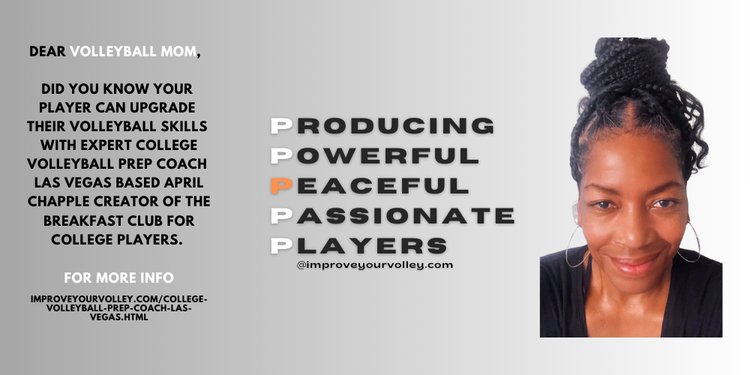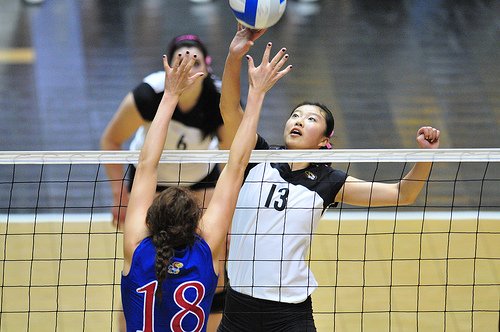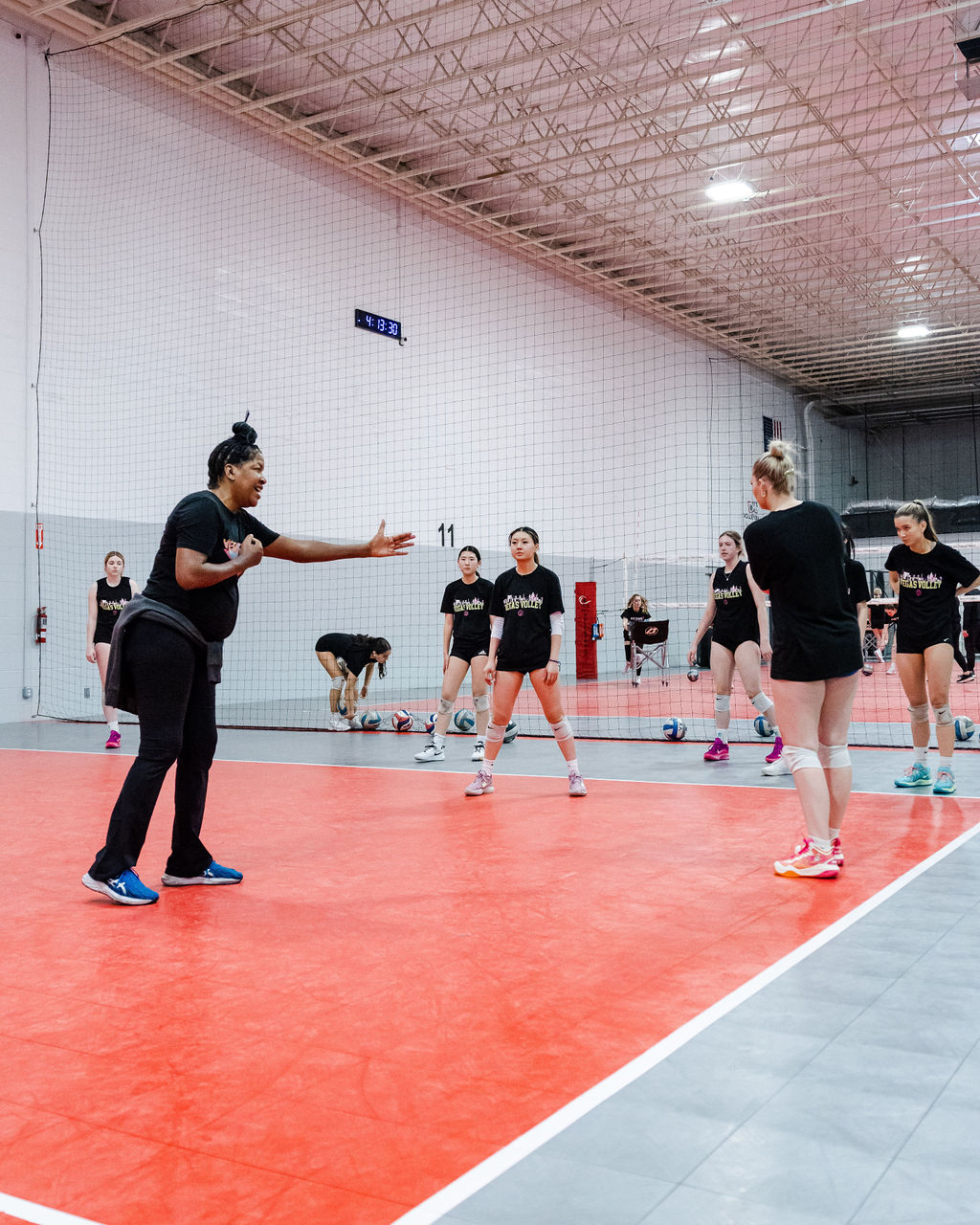- Improve Your Volleyball with Coach April
- Hard Driven Spike in Volleyball
- Short Volleyball Player Spikes
 Dear Volleyball Mom,
Do You Know What Sets My Private Volleyball Training Apart From Anyone In Vegas?
I invite You to read what my private volleyball training mission says before considering hiring me as a private volleyball coach because I'm not available for everyone.
Dear Volleyball Mom,
Do You Know What Sets My Private Volleyball Training Apart From Anyone In Vegas?
I invite You to read what my private volleyball training mission says before considering hiring me as a private volleyball coach because I'm not available for everyone.Short Volleyball Player Spikes: Score Points Against Big Blockers
These three short volleyball player spikes offer different attack hit strategy options like deep tips, cut shots and roll shots to score against big blockers.
This strategy is perfect for smaller athletes looking for short volleyball player spike options.
In order to score a point, you don't always have to hit the ball hard.
There are other types of volleyball ball attack hits you should know how to do that still require a spike approach but do not require you to make a fast and quick armswing to drive the ball with force into the opposing court.
Short Volleyball Player Spikes
How To Roll Shot the Ball So It Falls Behind The Block
This lifts the ball up and over the block and the rolling motion helps the ball fall quickly to the ground.
The roll shot is usually the third volleyball hit and is used to send the ball over the net in a rally.
Favorite places for hitters to tip the ball usually are
- behind the block
How To Do The Roll Shot in Volleyball
Here are more detailed step-by-step instructions for each type of spike, including footwork, arm positioning, and timing, tailored specifically for shorter players:
Lets review the roll shot technique.
1. Roll Shots:
- Approach: Begin by standing slightly behind the ball with your feet shoulder-width apart.
- Footwork: Take a quick three or four-step approach, coordinating your footwork with the type of set you and your setter have agreed upon, to generate power, momentum and lift towards the ball.
- Arm Positioning: As you approach the ball, position your hitting arm slightly behind your shoulder for a roll shot, keeping your elbow high and close to your ear.
- Timing: Time your jump to meet the ball at its highest point, allowing you to control the shot.
- Contact: Use the heel of your hand to contact the bottom front half of the volleyball, applying a rolling motion to lift the ball over the block.
- Aim: Direct the ball towards an open area behind the block, causing it to fall quickly to the ground. Great places to aim your roll shot for is over the middle blocker to the middle of the court which is the area often called the campfire area.
Short Volleyball Player Spikes
Sharp Cross Court - The Cut Shot
The Cut shot - is a ball hit at a sharp angle into the opposing court by a spiker.
For example if a hitter in Zone 4 hits a ball to Zone 2 in the opposing team's court, that's a cut shot in indoor volleyball.
How To Do The Cut Shot in Volleyball
2. Cut Shots:
- Approach: Position yourself behind the ball with your feet shoulder-width apart.
- Footwork: Take a quick four-step approach, coordinating with the setter's timing, generating power and momentum.
- Arm Positioning: As you approach the ball, keep your hitting arm high and slightly extended for a cut shot.
- Timing: Jump explosively off both feet, rotating your body to the desired direction of the cut shot.
- Contact: Direct your arm swing forward towards the ball while using your hand with a rigid wrist and keeping your elbow high, to make contact with the ball at a sharp angle, causing it to travel across the net at a sharp angle into the opposing court.
- Aim: Target a specific zone on the opponent's court, such as from Zone 4 to their Zone 4, or from your Zone 2 to their Zone 2 to execute the cut shot effectively.
Short Volleyball Player Spikes How To Use Your Fingertips To Tip The Ball Deep in the Court
Kenny works on deep tipping the ball to a basketball basket.
The Tip - is done after a spiker makes their three or four step approach to the ball as if to hit it hard, but with the hitting arm slows down their arm swing and
- contacts the ball with the soft pads of their fingertips
- to push the ball over the block and
- into an open space on the court.
Favorite places for hitters to tip the ball usually are
- behind the block and/or
- to the middle of the court
- deep to the corners of the court
where its harder for diggers to get to the ball.
How To Tip Deep in the Volleyball Court
3. Deep Tips:
- Approach: Start behind the ball with your feet shoulder-width apart
- Footwork: Take a quick four-step approach, coordinating with the setter's timing, ensuring proper positioning and generating vertical lift and momentum.
- Arm Positioning: As you approach the ball, slow down your arm swing and focus on using the fingertips of your hitting arm for contact.
- Timing: Time your jump to meet the ball at its highest point, allowing you to generate accuracy and precision.
- Contact: Use the soft pads of your fingertips to push the ball gently over the block and into open spaces on the court.
- Aim: Think about directing the ball behind the block, towards the middle of the court, or deep into the corners, making it challenging for opposing defenders to react and dig the ball.
6 ways short hitters use their agility, speed, and technical skills to overcome height disadvantages
Here's a breakdown of specific challenges faced by shorter players and how they can use their agility, speed, and technical skills to overcome height disadvantages in spiking:
1. Utilize Quick Footwork:
Shorter players often possess excellent agility and quickness on the court.
Use your nimble footwork to create better angles for your approach and avoid being easily blocked by taller opponents.
Focus on faster foot speed during your approach, allowing you to get in position quickly and effectively.
2. Develop Explosive Jumps:
While height may be a limitation, shorter players can still improve their vertical jump to maximize their attacking potential.
Work on plyometric exercises, such as jump squats and box jumps, to develop explosive power.
Strong legs and core muscles will help you gain height and generate extra power in your spiking.
3. Master Timing and Anticipation:
Understanding the timing and trajectory of the set is crucial for shorter players.
Anticipate the set's location and learn to time your approach perfectly to meet the ball at its highest point.
This will allow you to have a better chance of avoiding blockers and executing effective spikes.
4. Develop Technique and Accuracy:
Focus on improving your hitting technique to compensate for height disadvantages.
Work with coaches and trainers to fine-tune your arm swing, hand positioning, and ball contact.
By improving your technique, you can generate power and accuracy, making it harder for blockers to read your shots.
Check out these three outside hitter volleyball tips from USC All American Skylar Fields.
5. Be Creative with Shot Selection:
As a shorter player, you have the advantage of being more agile and unpredictable. Instead of relying solely on power, incorporate a variety of shots into your arsenal.
Practice roll shots, cut shots, and deep tips to keep blockers guessing and exploit open areas on the opposing court.
6. Communicate and Work with Your Setter:
Develop a strong connection and communication with your setter.
Collaborate to find the most effective angles and locations to attack from.
A well-coordinated connection with your setter will allow you to effectively utilize your speed, agility, and technical skills to make up for any height disadvantages.
7. Watch and Learn from Successful Short Players:
Study and analyze shorter players who have excelled in the sport.
Watch their playing style, tactics, and shot selection. Take note of how they use their agility, speed, and technical skills to their advantage.
Incorporate their strategies into your game and adapt them to suit your own strengths.
Watch how fearless these short outside hitters are when they attack the ball.
Remember, each player has their unique strengths and weaknesses.
Embrace your physical attributes as a shorter player and leverage your agility, speed, and technical skills to overcome height disadvantages.
Use what God gave you to your advantage like developing a very quick arm swing, along with a strong volleyball IQ.
Stay determined, practice consistently, and continue to develop your skills to become a successful and impactful spiker on the volleyball court.
Volleyball Ball Contact Strategy:
Where Do You Go From Here?
Where do you need to go now? Here are three options:
- Learn more about Smart Strategies by checking the links in Related Links section.
- Follow the suggested reading on our Sitemap page Learning How To Play (Sitemap)
- Or visit the pages in the How To Play Volleyball section in the drop down menu at the top of the page.
SUSCRIBE
To My Email Newsletter Below!
From Lady Vol to Legend: Coach April Produces Powerful Passionate Players...is that you?
What Are You Looking For?

Hi there!
Thanks for stopping by. Hope you learned something today that will help you reach your volleyball goals.
Be sure to subscribe to my email newsletter so you can learn more each week!
Stay strong! Stay motivated!
-Coach April

SUSCRIBE
to my email newsletter below!
Vegas Volleyball's Unsung Heroes: Celebrating Moms with Peace Love Volleyball Shirts
Ready to energize your volleyball mom journey?
Subscribe to my 'Producing Powerful Passionate Peaceful Players' email list above on ImproveYourVolley.com.
You'll receive energy-boosting tips, exclusive insights from me, Coach April Chapple on maintaining momentum in volleyball.
Let's power up the Vegas volleyball scene together!
Recent Articles
-
Volleyball Partner Passing Drills You Can Do To Improve Ball Control
Apr 21, 25 12:42 AM
These volleyball partner passing drills we do in Boot Camp classes are drills you can do at home in order to improve your consistency and ball control skills. -
The Volleyball Pepper Drill: Partner and Three Player Pepper Drills
Apr 19, 25 02:04 PM
The volleyball pepper drill is a ball control drill using setting, digging and hitting skills usually done as a partner or three player person drill in warmup. -
Best Volleyball Drills For Setters, Hitters, Liberos, Passers Blockers
Apr 19, 25 04:08 AM
Best volleyball drills are essential exercises in the learning process for players to improve your serving, hitting, passing, spiking, setting, blocking skills.





































